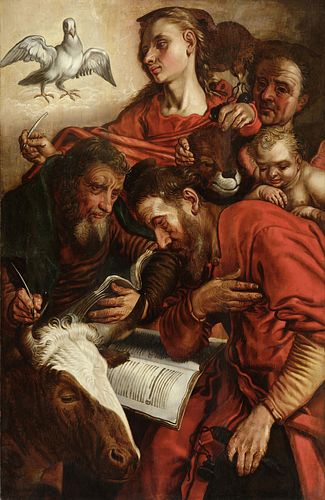PIETER AERTSEN (Amsterdam, 1508 - 1575). "The four Evangelists". Oil on panel.
Lot 79
About Seller
Setdart Auction House
Carrer Aragó 346
Barcelona
Spain
Setdart Subastas was born in 2004 and is currently the first online art auction in Spain with solidity, prestige and reliability guaranteed by our more than 60,000 users. Setdart has a young, dynamic and enterprising team ready to successfully manage the purchase and sale of art works through custom...Read more
Estimate:
EUR€25,000 - EUR€27,000
$26,881.72 - $29,032.26
Absentee vs Live bid
Two ways to bid:
- Leave a max absentee bid and the platform will bid on your behalf up to your maximum bid during the live auction.
- Bid live during the auction and your bids will be submitted real-time to the auctioneer.
Bid Increments
| Price | Bid Increment |
|---|---|
| EUR€0 | EUR€10 |
| EUR€200 | EUR€25 |
| EUR€500 | EUR€50 |
| EUR€1,000 | EUR€100 |
| EUR€3,000 | EUR€200 |
| EUR€5,000 | EUR€500 |
| EUR€10,000 | EUR€1,000 |
| EUR€20,000 | EUR€2,000 |
| EUR€50,000 | EUR€5,000 |
About Auction
By Setdart Auction House
Nov 3, 2021
Set Reminder
2021-11-03 08:00:00
2021-11-03 08:00:00
America/New_York
Bidsquare
Bidsquare : OLD MASTERS
https://www.bidsquare.com/auctions/setdart-auction-house/old-masters-7786
Setdart Auction House sofia@setdart.com
Setdart Auction House sofia@setdart.com
- Lot Description
PIETER AERTSEN (Amsterdam, 1508 - 1575). "The four Evangelists". Oil on panel. The board is reinforced. Measurements: 127 x 83 cm. Pieter Aertsen offers us here a magnificent composition of religious theme, which combines religious sentiment with a totally profane character derived from the mastery of the painter in the representation of animals, which transcend their symbolic meaning to be shown as completely real animals, totally physical. The composition is of great originality, typically mannerist, seeking the expressive tension that enhances the sacred and mystical character of the scene. We see the four Evangelists in a closed and pyramidal composition, squeezed into a space too small for their monumental figures, completely corporeal. The four evangelists, together with the symbols of the Tetramorphos (bull, lion, angel and eagle), appear organized in three levels of depth that bring three-dimensionality to the space, thanks to the masterful perspective work of the painter. In the foreground we see St. Luke and St. Matthew leaning towards each other, both with their Gospels open before them. St. Luke is accompanied by a superb all, pen in hand, and St. Matthew holds a cartouche for keeping scrolls in his left hand, while he holds his right hand to his heart, under the watchful eye of the child angel. In the background we see St. Mark, a youthful figure of enormous beauty and expressiveness, accompanied by a lion perfectly integrated into the tight composition. Finally, in the third plane, we see a St. John who is really a self-portrait of Pieter Aertsen himself, with a melancholic look and a face of marked naturalism, accompanied by the eagle, who carries in his beak a cartridge similar to that of Matthew. The figures are grouped in an off-centered pyramid, which tends to the right side, leaving in the upper left corner an empty space flooded with divine light, where the Holy Spirit appears in the form of a dove. A Flemish painter of the Mannerist period, Pieter Aertsen was the creator of a new genre, monumental scenes combining still life and costume painting, often including a biblical theme in the background. He was born and died in Amsterdam, then a relatively small city, and spent most of his career there, although he also painted in Antwerp, then the artistic center of the Netherlands. His genre scenes would be of key importance in the Baroque, both in his home country and in Italy, and in fact his scenes with peasants preceded by several years the better known scenes of Pieter Brueghel the Elder. Aertsen was a disciple of Allaert Claesz, and began his career painting religious subjects. Around 1550 he began to depict domestic scenes, in which he included furniture, kitchen utensils and food with great realism and attention to quality. His "Butchery with the Flight into Egypt" (Uppsala, 1551) is now recognized as the inaugural work of Nordic Mannerism, since it presents the "minor" subject in a leading role, leaving the religious subject in the background. A similar inversion of the hierarchy of genres can be found in the works, a few decades earlier, of Joachim Patinir, inventor of the landscape genre. However, unlike Patinir, Aertsen clearly depicts the religious theme, although it remains in a distant second place. On a formal level, his work shows the legacy of Jan Sanders van Hemessen, who represented numerous religious and moral scenes through a vision close to that of genre painting, with others of smaller size in the background, although clearly identifiable. Towards the end of his life, Aertsen also painted religious works with a more conventional treatment, although most of them were destroyed during the iconoclastic fury of the "Beeldenstorm".
- Shipping Info
-
In-house shipping available. Please inquire at admin@setdart.com.
-
- Buyer's Premium



 EUR
EUR CAD
CAD AUD
AUD GBP
GBP MXN
MXN HKD
HKD CNY
CNY MYR
MYR SEK
SEK SGD
SGD CHF
CHF THB
THB
















